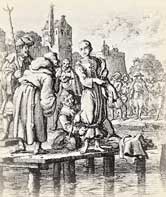Elizabeth Dirks was a trailblazer and a woman of great courage. Raised in a nunnery in East Friesland, she learned to read Latin and read the Bible through and through. She became certain that monasticism was not the way taught in Scripture. With the help of milkmaids she escaped and became a follower of peaceful Menno Simons. She was one of the first Reformation women ministers, probably a deaconness.
In 1549, Catholic authorities arrested her. When they found her Bible they knew they had the person they were looking for. Mistakenly, they thought she was the wife of Menno Simons. When they tried to get her to take an oath at her interrogation, she refused, saying Christ had taught that our yes should mean yes and our no mean no.
The record of her inquisition shows that the examiners asked her to inform on those whom she had taught. Knowing that this would lead to their arrest, she refused.
"No, my Lords, do not press me on this point. Ask me about my faith and I will answer you gladly."
"We will make it so tough that you will tell us," they threatened.
When she would not reveal who had baptized her or whom she had taught, they questioned her beliefs. She insisted that church buildings were not the house of God, for our bodies are the temple of the Holy Spirit. She denied that the New Testament spoke of the bread and wine as a sacrament but rather as the Lord's Supper. Asked if she were saved by baptism, she replied, "No, my Lords. All the water in the sea cannot save me. All my salvation is in Christ, who has commanded me love the Lord, my God, and my neighbor as myself." She denied that priests have authority to forgive sins--only Christ.
Still refusing to reveal who had baptized her, she was taken to the torture chamber and said, "So far we have treated you gently. Since you won't confess, we will put you to the torture."
A man named Mr. Hans applied screws to a thumb and fingers until blood spurted from under her fingernails. Still she wouldn't give away her friends, but her agony was so great that she cried aloud to Christ and received relief. So they lifted her skirt to apply torture to her shins. She pleaded that she had never allowed anyone to touch her body and they promised to respect her.
Then they crushed her leg bones with screws until she fainted. The men thought she was dead, but she came to and assured them she was not. Realizing that they could get nothing out of her, the authorities condemned her to die. Rather than burn her, as was customary, they tied her in a bag and drowned her on this day, March 27, 1549.
Bibliography:
- Bainton, Roland H. Women of the Reformation in Germany and Italy. Minneapolis, Minnesota: Augsburg, 1971.
- Williams, George Huntston. The Radical Reformation. Philadelphia, Pennsylvania: Westminster Press, 1962.
